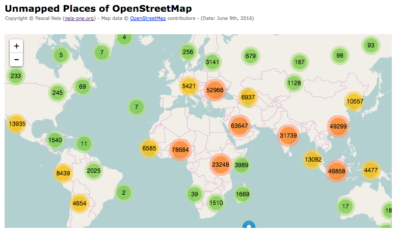Unmapped Places of OpenStreetMap – 2016
Back in 2010 & 2011 I conducted several studies to detect underrepresented regions a.k.a. “unmapped” places in OpenStreetMap (OSM). More than five years later, some people asked if I could rerun the analysis. Based on the latest OSM planet dump file and Taginfo, almost 1 million places have been tagged as villages. Furthermore, around 59 million streets have a residential, unclassified or service highway value. My algorithm to find unmapped places, works as follows:
- Use every place node of the OSM dataset which has a village-tag (place=village).
- Search in a radius of ca. 700 m for a street with one of the following highway-values: residential, unclassified or service.
- If no street can be found, mark the place as “unmapped”!
My results for the entire OSM planet can be found under the following webpage.
